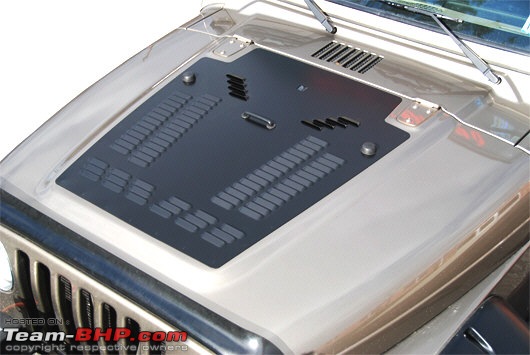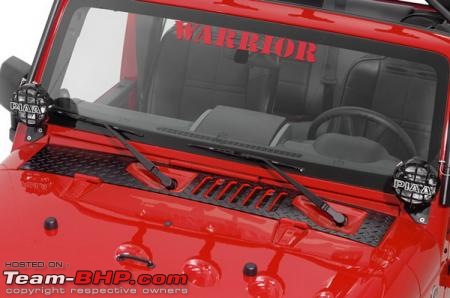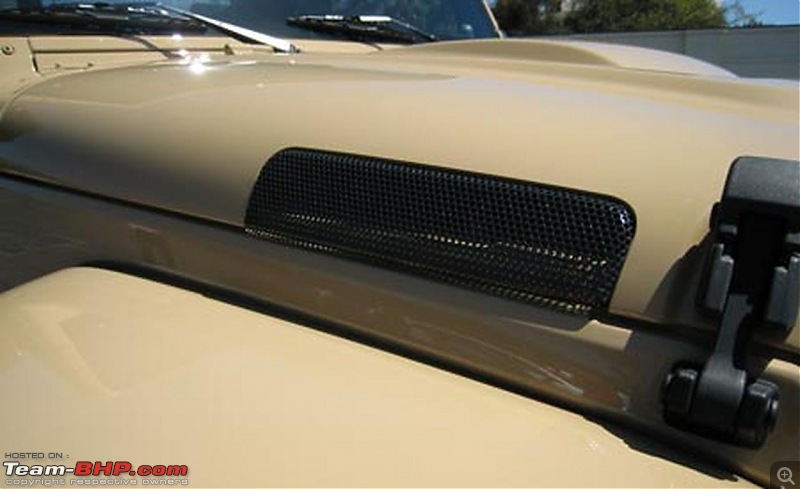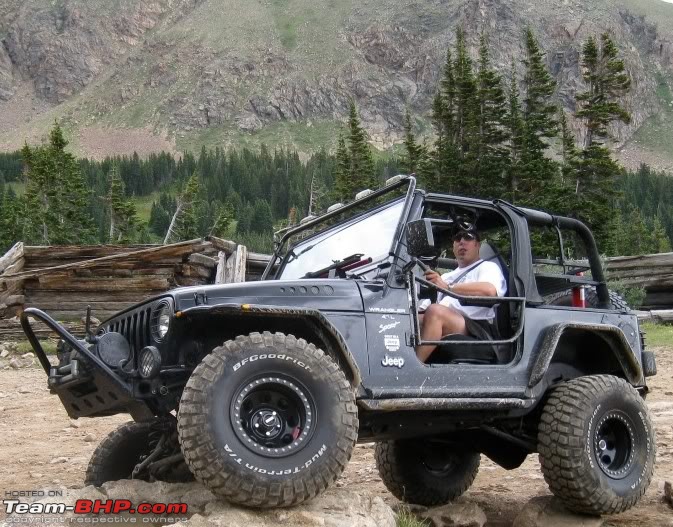Team-BHP
(
https://www.team-bhp.com/forum/)
Rationale:
Let hot air escape rather than allow cold air to enter or both?
Rather than physically cool the engine, it allows the engine to work more efficiently thereby preventing overheating.
Advantages:
- lowering temperatures
- Its a cumulative benefit on top of other mods IMO. Getting rid of that trapped hot air preserves parts, wiring and in general, eliminates some of the heat sink into the tub. (Robert J. yates - jeepforum.com)
- power gain (?)
Testimonials Quote:
stogie25:
I did home made vents. Using my Scangauge II to monitor the intake temperature the vents lowered the temperature approximately 30 degrees.
My readings are through the ECU from the air intake sensor as opposed to actual underhood temperatures. It is screwed into the intake manifold, above the header. The Jeep gets hottest when it has ran a while, then sat for a few minutes, then ran again. This is the condition at which I was taking my readings. With the hood complete, I was getting high temperatures in the 180's. With the vents, I am getting temperatures in the 150's. With the hood off the temperatures were in the 120's.
One can feel the hot air billowing out of the vents when I park the Jeep.
Attachment 1062012
Source: http://www.jeepforum.com/forum/f9/ho...-work-1064062/
|
30° Fahrenheit is ~ 16.6° Celsius using a formula from Wiki.
180° F ~ 100° C & 150°F ~ 83.3° C
Quote:
PhulesAu from jeep forum.com
Yes they work very well. Especially at slow speeds and when towing.
|
Quote:
Border Dave
In the summer, my hood would get so hot I couldn't lift if after I'd been driving it. After I installed the hood louvers, I could easily lift the hood after driving the Jeep. Also, before the vents, my emissions hoses rotted clean through after only three years. Since I installed the vents six years ago, I haven't had any underhood heat related problems since.
Source: http://www.jeepforum.com/forum/f9/ho...62/index2.html
|
Quote:
With a deep understanding of this particular topic, YES THEY WORK, assuming they're done correctly.
I have accurate intake temp data logs to prove as well as a dyno-sheet showing a 7-10whp gain.
Source: 05TurboS2K : http://www.jeepforum.com/forum/f9/ho...l#post10055083
|
Possible Cons to Hood Vents:
- Heat damaging paint as told by a member of jeep forum.com
- weaken the strength of the panel (?)
- Rain getting in. Solution: install a rain gutter
- water getting in while pressure wash. Solution: keep vent position away from fuse boxes, battery, etc
Quote:
That being said....all I can say is that in the 10+ years of my washing the TJ's engine compartment with a high pressure nozzle at the local car wash....it hasn't seem to bother anything. And that was done on a fairly frequent basis. My reasoning then is that the rain, dribbling in through the vent, doesn't hurt it either.
Stu Olsen : http://www.jeepforum.com/forum/f9/ho...ml#post9769194
|
Points to ponder:
- For good circulation, louvres would work better than vents
- if water running through an engine can't cool it, how will cooler air over it do it?
The opponents of vents say that it just prevents fading of the paint over the bonnet rather than lowering temperatures.
Another option to reduce temperature:
Quote:
Border Dave:
One quick way to reduce intake and manifold temps is to wrap the intake tube with header wrap or a insulated foil backed product from Thermotec. That right there dropped my intake temps 50*.
I have a Scanguage hardwired into my rig and I can monitor IAT temps real time. Wrapping my intake tube took me all of 10 minutes so the weather and temp variables were unchanged when I measured the results.
Source: http://www.jeepforum.com/forum/f9/ho...ml#post9760007
|
50° F ~ 27.7° C
Here's a pic of a wrapped intake of member TJeeper from jeep forum.com:

Quote:
That's about the sum of it. And any cooler air is good, in my opinion...I'm just not counting on lots of power from it.
As far as data for proving heat soak is concerned, it's simple conduction and convection. There's no way air of a given temperature can contact/pass over a surface of a differing temperature and not be affected. It's simple energy transfer, and it has to do with one of those pesky laws that make up "science." Now, it might be a very, very slight change in our case of intake tubes, but it does happen. Nitpicking, I know.
I think the cowl intake, along with an insulated intake tube and good louvers would make a very effective way of lowering the temperature in the intake. Of course, the intake itself will get hot, but it will also be radiating that heat back out into air that's much cooler...again, simple conduction and convection.
Source: Sundowner from: http://www.jeepforum.com/forum/f9/ho...ml#post9763626
|
Can i use a hood scoop like the ones used to feed air to the intercooler?
NO, unless mounted in reverse direction.
Quote:
That's exactly the opposite of the louvers. You need the hot air to escape from under the hood not add air to it. The scoops would work on a RAM AIR system or a turbo system where the intercooler is under the scoop like Impreza's.
The louvers are vents which hot air can excape from when moving
http://www.jeepforum.com/forum/f9/ho...l#post10067584
|
Experiments and good reads:
http://jeepsunlimited.com/forums/sho...ght=hood+vents http://www.oman4x4.com/hoodvents.htm (has part of above text quoted, but with pics)
Going through the pros and cons, i'm still not 100% convinced, but having said that, i'm still going to experiment with the wrap and hood vents (holes on the side of the hood) in my jeep.
Thread moved from the Assembly Line -> 4x4 Technical. Thanks for sharing!
Quote:
Originally Posted by Tejas@perioimpl
(Post 3064811)
Going through the pros and cons, i'm still not 100% convinced, but having said that, i'm still going to experiment with the wrap and hood vents (holes on the side of the hood) in my jeep.
|
Why aren't you convinced? They will definitely work provided the vents are placed facing the cabin like shown in the one of the photos with the vehicle having multiple louvers on the hood.
As far as weakening of the hood is concerned, I'm sure welding a few small strengthening bits near the vents will solve the problem.
A friend of mine had found a very simple solution for his over heating turbo esteem. On the esteem below the hood there is a rubber beading which prevents rain water rolling off the wind shield from entering the engine bay. His solution was to simply remove that beading and create a small air gap along the width of the hood for hot gases to escape. While the car was moving, the hot air would escape through this gap and flow over the wind shield. Simple, ingenious and super effective. This air gap was only about 4 - 5 mm but still it worked wonders.
Well, let me rephrase. I'm not convinced that they would lower the temperature, rather they would prevent or delay the rise in temperature IMO.
I'm going to make 2 holes on either side of my jeep bonnet. Was advised against slits for the structural integrity issue since many times, we do stand on the bonnet of the jeep.
They will lower the overall temperature inside the engine bay as there will be constant air flowing through it. The effect of this air flow would be that the existing cooling system would be super efficient as it does not have to work very hard to keep the engine at optimum operating temperature and also less chances of engine overheating.
Edit: You have also mentioned that if water cannot cool the engine, how can air? Well, water also needs air to cool and hence we have the radiators and cooling fans. Air cools water cools engine. :)
Yes removing hot air from inside the cabin should cool the engine. Further in many cars there is a carpeted mold attached to the underside. During summers if one was to remove it and let the heat dissipate through the metal sheet itself, would it help or increase the temperature even more due to the heating effect of the sun onto the metal hood? I think during movements it would cool but fry up the insides of a parked vehicle.
Hi,
I am no expert in this, but was told that the reason the CJ3B has vertical vents below the mudguard was to dissipate the head from with the engine bay. The way it works is simple, when the vehicle is in motion ambient air flows over the vents creating a vaccum over the vents therby ensuring the air gets sucked out from within the engine bay. If you look at any CJ3B you will notice air vents behind the front tyres. The guy who told me this could be pulling the wool over my eyes.
Vijay
Wow what a informative thread !! especially in the jeep case the vents is a must. Because the the air flow will be very high on a performance Diesel Jeep in off road ( air flow will be high in 4L:Frustrati).
What is the root reason of over heating of a Jeep Engine ? Mainly DP & XD3P ? why Di/MDi is not over heating as XD3P ? its should have been too easy to add a air vent to prevent a Engine rebuild :uncontrol.
Interesting compilation, btw, this query is related to Jeeps in general or a particular vehicle + engine combo ?
Quote:
Originally Posted by sreejeshmp
(Post 3066417)
What is the root reason of over heating of a Jeep Engine ? Mainly DP & XD3P ? why Di/MDi is not over heating as XD3P ? its should have been too easy to add a air vent to prevent a Engine rebuild :uncontrol.
|
Sreejesh, Jeeps overheat due to various reasons. The easiest workaround we see these days is to add a bigger radiator, which treats the symptom and not the cause.
Air circulation using scoops is definitely a good idea, what if it does not cool the engine, it would still look cool right ?;)
Spike:D
Quote:
Originally Posted by Tejas@perioimpl
(Post 3065011)
Well, let me rephrase. I'm not convinced that they would lower the temperature, rather they would prevent or delay the rise in temperature IMO.
|
Tejas, hood vents, as long as they are properly designed, ie, they dont hinder the normal flow of air, but only add to it, definitely make a difference, and there is no doubt about it. However my take on these is:
- Hood Vents are helpful as long as there is Ram Air. And for Ram Air to be helpful, the speeds should atleast be 40+ kmph (?).
Now, considering the fact that most of our Jeeps overheat while off-roading/load carrying and not(mostly) on-roads, I doubt the practicality of this mod in reducing the engine temperature.
However:
- Hood Vents only help, and do not do any harm (if properly placed and designed).
- They look good.
- There is a small fraction of jeeps(like mine) which overheat when you travel @100kmph for more than 10-15 minutes. These would definitely help them.
Quote:
I'm going to make 2 holes on either side of my jeep bonnet. Was advised against slits for the structural integrity issue since many times, we do stand on the bonnet of the jeep.
|
Yes, I think they might have an impact on the structural integrity. However, like vikram mentioned, you should be able to find a way around.
My Take: Yes, Hood Vents are worth a try.
This a interesting topic, i would say that its simple science on convection ,hot air rises high and needs to escape through the vents you should have vents or holes on the bonnet or check the air flow in a wind tunnel and come out with the correct position of those vents . I remember seeing Diesel locomotive have big fans and radiators on the top , this looks like is already being put in use by Railways.
| All times are GMT +5.5. The time now is 18:29. | |













